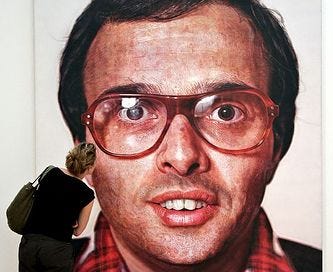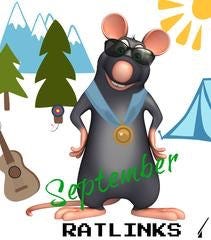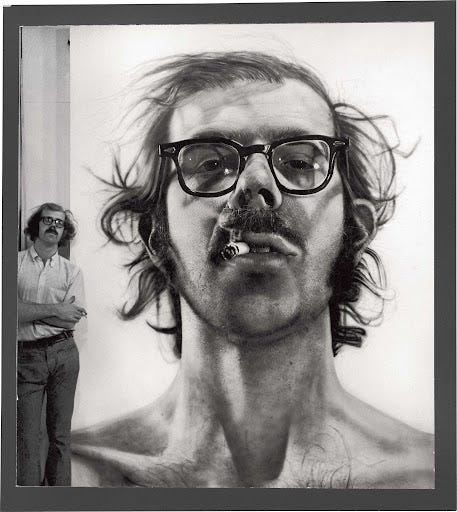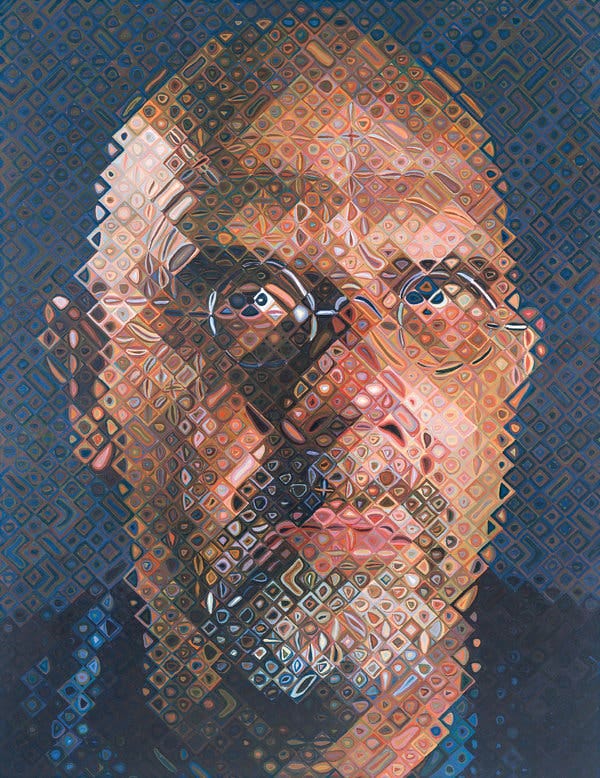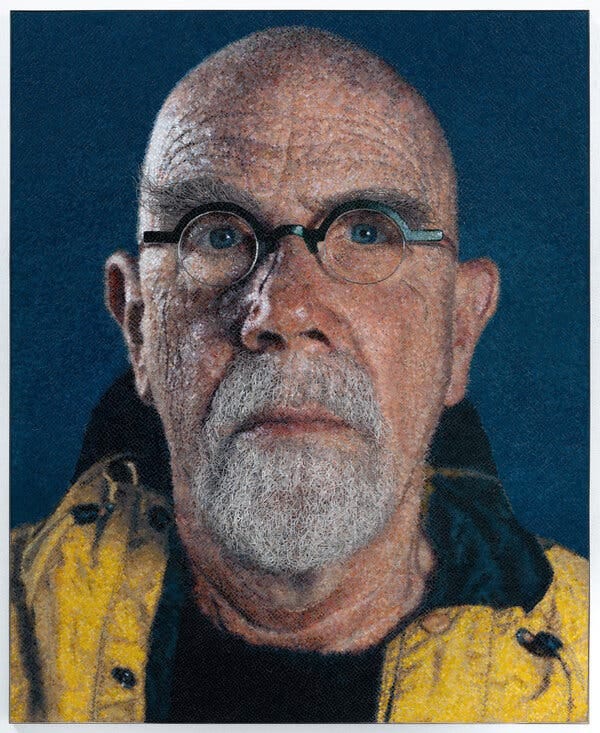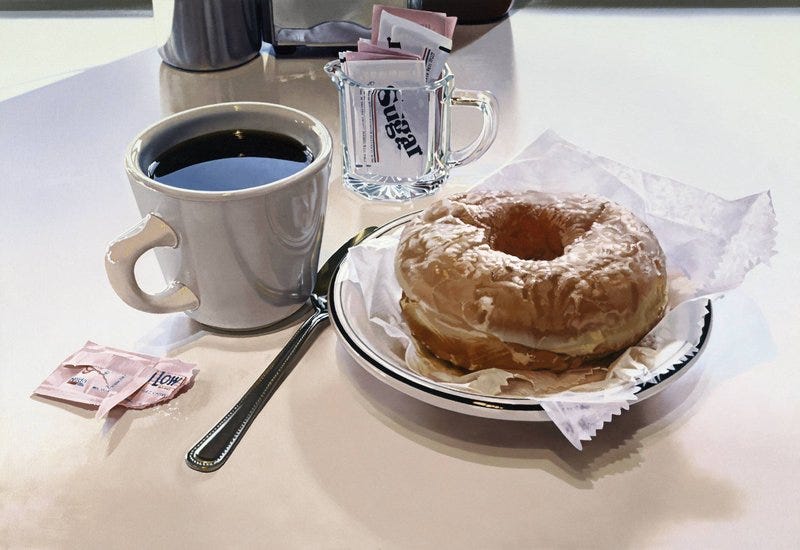Welcome back and a big thank you to all the working people in the US and Canada. You earned the first Monday of September, so enjoy it. To all the retired people enjoy your every day off.
Labor Day also means summer is “officially” over and white pants are no longer acceptable. Please put said pants back into cold storage before the fashion police are called. Stop trying to make winter white a thing, Gretchen.
PINCH TO ZOOM
When art critics get together they talk about Form and Structure and Meaning. When artists get together they talk about where you can buy cheap turpentine.
― Pablo Picasso
Many moons ago, I visited New York’s Museum Of Modern Art (MOMA) where I saw a painting that struck me. We will get to that painting, entitled “Mark” later. Let’s first focus on its artist Chuck Close, who died this month at the age of 81.
Chuck Close, rose to prominence in the 1970s and ’80s with colossal photorealist portraits of himself, family members, and fellow artists. Adept at transforming photographs into paintings of such aggressive visual and psychological impact.
In the 1970s, he began to translate his photographic sources into pixelated images, filling in the individual cells of a grid with distinct marks, colors, and tones that would cohere into photographic images when viewed from a distance.
In New York, on Dec. 7, 1988, he was felled by what turned out to be a collapsed spinal artery, which initially left him paralyzed from the neck down. In the ensuing months of rehabilitation, he began to regain movement in his arms, and he was able to sit up and paint using brushes strapped to his hand. His condition forced him to devise a new way of working that actually rejuvenated and improved his art.
Informally known as the Mayor of SoHo, at times he seemed like the chief uptown representative of the downtown art world. Close was equally admired by the cognoscenti and the public but was not without controversy.
Late in his career, he faced accusations of sexual harassment, behavior potentially caused by frontotemporal dementia a disease that affects executive function, destroying the part of the brain that governs behavior and inhibits base instincts. However, these accusations cast a pall over his career and legacy.
Close was a particularly great one-hit wonder, twice.
His idea of the head rendered colossal and detailed enough to dislodge anyone’s socks propelled portraiture into the 21st century, and supported a certain kind of lateral expansion — a franchising, if you will.
It translated well into different mediums — prints, drawings, Polaroids, paper-pulp collages, ink-stamped fingerprints, daguerreotypes and even tapestries.
Every time the medium changed, the work changed physically, but it wasn’t enough.
This lateral growth provided only the appearance of development, but actually there was very little in Close’s work.
Only his paralysis had forced his idea of scale and process into new territory — perhaps beyond his wildest imagination.
Roberta Smith, Chuck Close’s Uneasy, Inevitable Legacy1
NFT.JPEG
We find that whole communities suddenly fix their minds upon one object, and go mad in its pursuit; that millions of people become simultaneously impressed with one delusion, and run after it, till their attention is caught by some new folly more captivating than the first.
— Charles MacKay, Extraordinary Popular Delusions and the Madness of Crowds
Art is constantly evolving from Michaelangelo painting the Sistine Chapel to a guy taping a banana on a wall at Art Basel. At present, the hottest trend in the “art world” is the non-fungible token, or NFT.
An NFT, in layman’s terms, is a new kind of digital collectible item that is stamped with a unique bit of code that serves as a permanent record of its authenticity and is stored on a blockchain, the distributed ledger system that underlies Bitcoin and other cryptocurrencies.2
NFTs appear to be the best way to convert your already appreciated crypto assets into a different rapidly appreciating currency that also happens to be an image.
The most valuable NFTs today are a series of 10,000 pixelated people called CryptoPunks. The average punk is currently selling for north of $200,000. OpenSea, the leading NFT marketplace, did over $1b in transactions this month. Last week, it had multiple days with over $100m in transactions per day. The series of NFTs known as Bored Ape Yacht Club launched a new NFT set on Saturday night and generated $90m that evening.
Like almost all art, NFTs were created to be displayed but digital assets are a bit too “outsider” for traditional museums. At present, the most common way to showcase your NFTs is by making the image your profile picture (PFP), which celebrities like Jay-Z and Steph Curry have done.
Unfortunately in May, I decided against buying a CryptoPunk as I didn’t think at the time that it was wise to spend $35,000 on a jpeg. Obviously, I am an idiot as that picture would be worth close to 10x that today. Especially with companies like Visa jumping into the NFT space, purchasing a CryptoPunk for close to $150,000.
SIDE PROFILE
My profile picture remains the same, as it has for the past twelve years, a thumbnail of the Chuck Close painting “Mark”.
There have been quite a few instances upon meeting someone for the first time where I am asked if the photo is me. While I look nothing like “Mark” this mix-up could be due to the extreme realism Close achieved in the portrait of his friend the painter Mark Greenwold.
What do NFTs like Bored Apes or CryptoPunks have in common with Chuck Close?
Closes art’s popularity through its ubiquity and sameness becomes a kind of corporate brand, standing for contemporary museum art. NFTs attempt to claim to be contemporary digital art.
NFTs prices like Close’s big visages continue to startle and even thrill without offending. They are both extremely accessible and slightly sensational at a time when museums are being careful to play down their elitism and push public outreach.
A few months ago inspired by the NFT craze, I unsuccessfully attempted to purchase a print of “Mark”. At present, I do not own a print nor the rights to Mark. My profile picture is either from a photo of the painting I took at the museum or more likely, I right-clicked and saved the image off of the internet.
Why buy an NFT?
How is it possible that a digital image is worth more than a house?
Can’t you just save the image and keep it on your computer to look at at any time?
Sure, but then you wouldn’t “own it” and most importantly be able to flip it to other collectors.
Beware tulipmania.
Men, it has been well said, think in herds; it will be seen that they go mad in herds, while they only recover their senses slowly, and one by one.3
Once the exuberance wears off, or liquidity dries up this has the potential to go up in flames.
Call me old school, I still prefer the physical world over the meta-verse but maybe it is all just the same?

